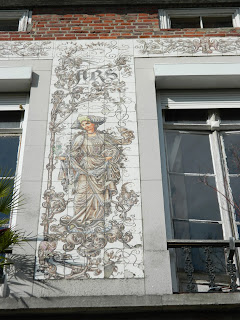
The street, named after a monastery around the corner, is lined with two and three story houses which date to at least the 19th century. It is possible that some of the houses are older, however, since the women of the monastery after which the street is named dates to the 17th century.
One house, in particular, caught my attention. Across the brick facade of the building a series of panels weave around three bay windows under the roof.
 |
| Theresianenstraat 24, Ghent |
The word faïence is associated with French merchants who were exporting tiles from northern Italy, where the process was perfected in the late Renaissance.
According to city records, Theresianenstraat 24 was built around 1835. Later it was owned by Camille Ganton (1872 - 1946), a ceramicist and glass painter who, while still a student in 1893, won an award for his work from St Lucas - Ghent an architecture and design school in the city.
The Ganton family came from Lyon, France to Ghent, Belgium in 1797, toward the end of the French Revolution. It's likely there is a story there, about their migration east, although I have not yet discovered it.
At any rate, a couple generations after the family's move to Ghent, Camille Ganton learned the craft of glass painting from his father, Jean Baptiste Ganton. By the time he was 27 years old, Ganton had established himself as a glass painter, ceramicist and engraver with a shop on Theresianenstraat.
Here one can see the bronze name plate on Ganton's door, a signal of his pride and artistry.
 |
| bronze name plate at Theresianenstraat 24, Ghent |
Because Camille's two brothers also set up glass painting shops in Ghent, Camille changed his name to Camille Ganton-Defoin, adding his wife's last name as a way to distinguish his work, and perhaps to honor Elise Defoin who worked in the shop with Camille.
Ganton-Defoin became a reputable glass painter and artisan, obtaining commissions across Belgium.
For instance, he painted the windows at the Catholic parish church of Saint-Hubert in Aubel, Belgium. A close-up photo of a panel shows his signature and symbol of the bear in the lower corner under the scene of the Annunciation.
 |
| signature of Camille Ganton-Defoin Saint Hubert, Aubel, Belgium photo courtesy of G Friehalter |
 |
| Camille Ganton-Defoin bear motif facade of Theresianenstraat 24, Ghent |
The woman is dressed elegantly, while the man holds a palette and paint brushes. It is possible that the woman is a representation of Elise Defoin while the man is a portrayal of himself.
As I continue to research the life and work of Camille Ganton-Defoin it becomes clear that this could become a much larger work than simply a blog entry. He represents a paradox. The work he did was traditional, from an old school practice of glass painting. Yet he was modern, in that he adopted his wife's last name at a time when this was almost incomprehensible. Thus, for now, I will simply leave you with these images and the compelling idea that there is much more to come.
 |
| ARS |
 |
| LABOR |




No comments:
Post a Comment